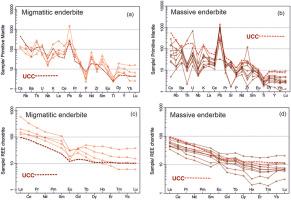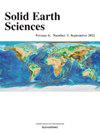Petrogenesis of post-collisional mesozonal enderbite in the Proterozoic Chhotanagpur Gneissic Complex, Eastern India: Implications of slab-break-off
IF 2
4区 地球科学
Q3 GEOSCIENCES, MULTIDISCIPLINARY
引用次数: 0
Abstract
Collisional orogeny produces large volumes of tonalitic melts at two stages: first, during the oceanic subduction below the continent (continental arc), and again, during the post-collisional stage. In a polydeformed and polymetamorphosed terrain, it would be challenging to distinguish between arc tonalites and post-collisional tonalites (and their metamorphosed equivalents, enderbites). The Chhotanagpur Gneissic Complex (CGC) belongs to the EW to ENE-WSW tending, 1500 km long Grenvillian collisional belt amalgamating the North and South Indian cratonic blocks. We discuss the field disposition, petrography, mineral chemistry, geochemistry, the physical condition of crystallization and metamorphism, and the petrogenetic model of enderbites from the CGC. Enderbites sporadically occur as cm-to-dm-thick leucosomal bands in migmatitic gneisses (migmatitic enderbites) and as small stock-sized plutons (massive enderbites) intruding migmatitic gneisses. Both of these types intruded before the end of the regional deformation. Both the massive and migmatitic enderbites predominantly contain plagioclase, quartz, biotite (with a higher abundance in the migmatitic type), minor orthopyroxene, clinopyroxene, hornblende, K-feldspar, and accessories such as opaque minerals, apatite, and zircon. Garnets rarely occur in migmatitic enderbites. Thermodynamic modeling suggests a low liquidus temperature (∼750 °C), intermediate pressure of emplacement (∼5.5 kb), moderate oxygen fugacity (ΔQFM = +1 to +2), and low water (∼4.0 wt%) of the parental tonalite magma. The two enderbite types have been derived from two distinct crustal (amphibolites) sources by water-fluxed partial melting at <10 kb pressure, shallower than the garnet stability field. About 20–40 % of batch-melting of shoshonitic basaltic sources yielded migmatitic enderbites, while about 40–70 % of batch-melting of within-plate basaltic sources produced massive enderbites. Discrimination diagrams display a post-collision tectonic setting of these enderbites. The migmatitic enderbites and magma of enderbite plutons formed during regional anatexis due to thermal relaxation in the lower crust after attaining peak pressure during the decompressive phase of regional granulite facies metamorphism (1000–950 Ma) related to slab breakoff at the post-collisional stage of the orogeny. Mantle-derived magmas formed by adiabatic decompression in the upper mantle supplied the heat.

印度东部新生代 Chhotanagpur 片麻岩群碰撞后中生代内闪长岩的岩石成因:板块断裂的影响
碰撞造山作用在两个阶段产生了大量的辉绿岩熔体:首先是在大陆(大陆弧)下方的大洋俯冲过程中,其次是在碰撞后阶段。在一个多变形和多变质的地形中,要区分弧状英安岩和碰撞后英安岩(及其变质的等同物--内斜英安岩)是非常困难的。乔塔纳格布尔片麻岩群(CGC)属于东-西向东-西-西南走向,长 1500 千米的格勒维利碰撞带,将北印度和南印度的板块合并在一起。我们讨论了来自CGC的enderbites的野外布局、岩石学、矿物化学、地球化学、结晶和变质的物理条件以及岩石成因模型。内闪长岩以厘米至分米厚的白云母带形式零星出现在偏闪片麻岩中(偏闪长岩内闪长岩),以及以侵入偏闪片麻岩的小型块状岩体(块状内闪长岩)形式出现。这两种类型都是在区域变形结束之前侵入的。块状内闪长岩和偏闪长岩都主要含有斜长石、石英、斜长石(偏闪长岩中含量较高)、少量正长石、霞石、角闪石、K长石以及不透明矿物、磷灰石和锆石等附属物。石榴石很少出现在偏闪内斜岩中。热力学模型表明,母体英安岩岩浆的液态温度较低(∼750 °C),成岩压力中等(∼5.5 kb),富氧能力适中(ΔQFM = +1 至 +2),含水量较低(∼4.0 wt%)。两种内闪长岩类型分别来自两种不同的地壳(闪长岩)来源,在比石榴石稳定场更浅的<10 kb压力下通过水通量部分熔融而形成。大约20-40%的斜长岩玄武岩源批量熔融产生了偏闪长岩内闪长岩,而大约40-70%的板内玄武岩源批量熔融产生了块状内闪长岩。判别图显示了这些内斜岩的碰撞后构造背景。在区域花岗岩面变质作用的减压阶段(1000-950Ma),由于下地壳的热松弛,在区域性厌氧过程中形成了偏闪长岩内闪长岩和内闪长岩柱岩浆,这与造山运动后碰撞阶段的板块断裂有关。上地幔绝热减压形成的地幔源岩浆提供了热量。
本文章由计算机程序翻译,如有差异,请以英文原文为准。
求助全文
约1分钟内获得全文
求助全文
来源期刊

Solid Earth Sciences
GEOSCIENCES, MULTIDISCIPLINARY-
CiteScore
3.60
自引率
5.00%
发文量
20
审稿时长
103 days
 求助内容:
求助内容: 应助结果提醒方式:
应助结果提醒方式:


